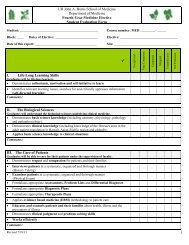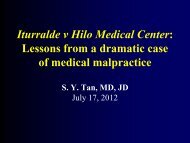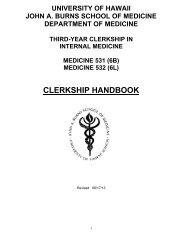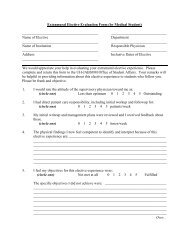clerkship handbook - University of Hawaii â Department of Medicine
clerkship handbook - University of Hawaii â Department of Medicine
clerkship handbook - University of Hawaii â Department of Medicine
Create successful ePaper yourself
Turn your PDF publications into a flip-book with our unique Google optimized e-Paper software.
any area(s), the Site Coordinator should immediately notify the Clerkship<br />
Director who may further discuss the student’s performance and possible<br />
remediation with the <strong>Department</strong> <strong>of</strong> <strong>Medicine</strong> Student Education Committee.<br />
(See Student Evaluation Form and Honors/AOA Evaluation Form)<br />
i. Serving as a member <strong>of</strong> the <strong>Department</strong> <strong>of</strong> <strong>Medicine</strong> Student Education<br />
Committee (SEC). The Site Coordinator attends the committee’s monthly<br />
meetings to act as a spokesperson for the students assigned to his/her site,<br />
reporting on students’ performance and progress and recommending<br />
commendation and remediation when appropriate. In addition, SEC members<br />
participate in the oversight, development and implementation <strong>of</strong> all <strong>of</strong> the<br />
<strong>Department</strong> <strong>of</strong> <strong>Medicine</strong>’s 3 rd and 4 th year clinical rotations.<br />
j. Monitoring students’ work hours, dedicated study time, days <strong>of</strong>f and<br />
absences. (See Work Hours, Dedicated Study Time and Days Off section.)<br />
k. Serving as mediator in the event students encounter problems at their<br />
assigned site. Problems may include <strong>clerkship</strong> requirements, <strong>clerkship</strong><br />
performance, absences, mistreatment, harassment and abuse. The Site<br />
Coordinator should refer significant problems to the Clerkship Director and/or the<br />
<strong>Department</strong> <strong>of</strong> <strong>Medicine</strong> Student Education Committee.<br />
3. Additional responsibilities <strong>of</strong> Hospital Site Coordinators include, but are not<br />
limited to:<br />
a. Assisting in Team Assignments - the Hospital Site Coordinator will assist<br />
the Chief Medical Resident with the assignment <strong>of</strong> students to medical<br />
teams.<br />
b. Leading PBL Tutorial. This should occur on average once a week<br />
throughout the <strong>clerkship</strong> and each session should last on average 2 – 3<br />
hours. (See PBL Tutorial description.)<br />
c. Insuring that Bedside Clinical Skills occur 1 – 2 times each week and<br />
Chief Medical Resident Rounds occur 1 time each week and monitoring<br />
students’ attendance at these as well as at other hospital conferences<br />
and rounds deemed to be <strong>of</strong> educational value by the Hospital Site<br />
Coordinator.<br />
The Ambulatory Attending’s Role<br />
1. Introduction:<br />
The ambulatory attending, or preceptor, is a critical element for student learning in<br />
Internal <strong>Medicine</strong> as it is practiced in the ambulatory milieu. Although sometimes<br />
lacking the drama <strong>of</strong> inpatient medicine, the outpatient setting <strong>of</strong>fers special skills sets<br />
in learning and teaching critical thinking, decision making, clinical skills and judgment,<br />
and patient-physician communication in Internal <strong>Medicine</strong><br />
2. Responsibilities:<br />
a) The ambulatory attending/preceptor will serve as a role model for excellence<br />
in ambulatory primary internal medical practice, to include thoughtful, evidence-<br />
22






